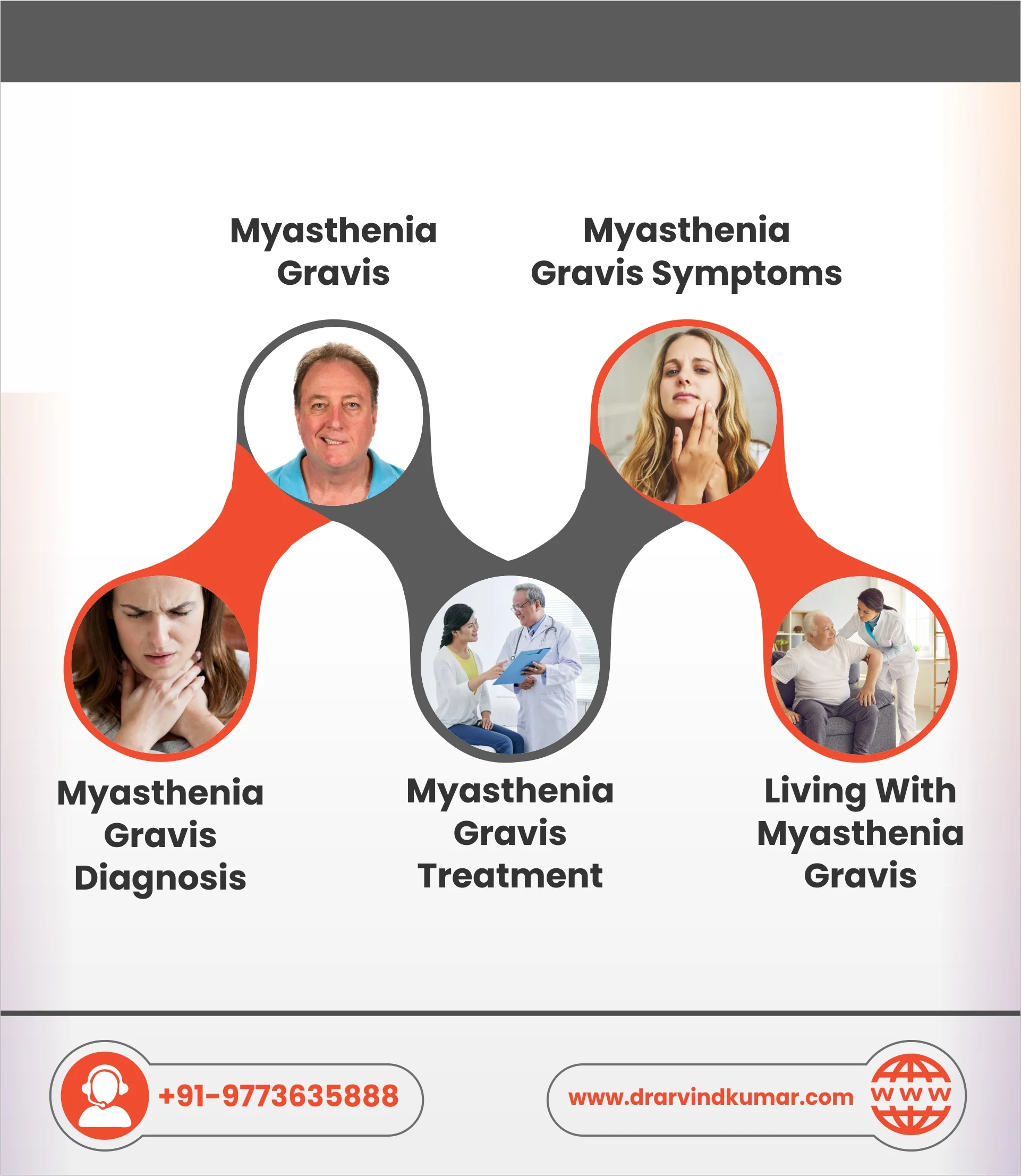Myasthenia gravis (MG) is a chronic disease, which makes managing it difficult. Currently, there is no complete cure for this autoimmune disease, which results in fatigue and muscle weakness. Although the conditions symptoms can be treated medically, people with it are more likely to experience stress and melancholy.
The good news is that most individuals with Myasthenia gravis can lead active, fulfilling lives with the right management and coping mechanisms. Let us read further to learn about Myasthenia gravis, its symptoms, treatment, and how to seek proper Myasthenia gravis support & coping strategies.
Myasthenia Gravis
Due to the inflammatory nature of myasthenia gravis (MG), the bodys immune system unintentionally targets its own tissues. The interaction of the nerves and musculature is impacted by MG. (the neuromuscular junction).
People who have MG become incapable of actively controlling their muscles. They feel varying degrees of fatigue and muscular weakness. They might be unable to move their limbs, neck, eyes, or facial muscles. MG is a chronic muscle condition. Although there is no known treatment for the disease, some individuals may experience remission.
Myasthenia Gravis Symptoms
Initial myasthenia gravis symptoms frequently appear abruptly. When you are active, Your muscles weaken due to neuromuscular illness. When you rest, your muscles regain their power.
The degree of muscular weakness frequently varies from day to day. Most people feel most energetic earlier in the day and their worst in the evening.
Myasthenia gravis symptoms include:
- Double vision.
- Droopy eyes (ptosis).
- Speech, chewing, or swallowing challenges.
- Having trouble lifting the neck or supporting the head.
- Limb fragility.
- Difficulty walking.
Rarely MG can impair the respiratory systems muscles. You might experience breathlessness or more severe respiratory issues.
Myasthenia Gravis Diagnosis
For a myasthenia gravis diagnosis, your healthcare professional will examine you physically and evaluate your symptoms. You could take these tests:
Ice pack test: If your eyelids are seriously drooping, your healthcare provider may apply ice packs or ask you to close your eyes and relax in a dark area for a few minutes. You might have MG if the drooping improves after you apply ice or take time to relax.
Antibody tests: In at least 85% of people, abnormally high levels of acetylcholine receptor antibodies are observed in cases of myasthenia gravis. Antibodies against muscle-specific kinase (MuSK) are present in about 6% of cases. Less than 10% of MG individuals may not have antibodies.
Imaging scans: A CT or MRI can be used to look for tumors or other issues with the thymus organ.
Repetitive Nerve Stimulation Test (R.N.S.T.) : An RNST is a test that gauges the electrical activity of the muscles and nerves. This exam looks for issues with nerve and muscle communication. With increasing stimulation, there is decremental response in the muscles.

Myasthenia Gravis Treatment
Myasthenia gravis treatment allows the majority of patients to lead reasonably normal lives.
The goal of Myasthenia gravis treatment is to reduce symptoms. Myasthenia gravis treatment consists of:
Medications: Anti-cholinesterase agents increase communication between nerves and muscles to increase muscular strength. Corticosteroids and other immunosuppressants lower abnormal antibody production and inflammation in your body.
Monoclonal antibodies: You get biologically designed protein intravenous (IV) infusions. These proteins reduce the immune systems overreaction.
IV immunoglobulin (IVIG): Over the course of two to five days, you receive IV doses of donor antibodies. Both myasthenia crisis and widespread MG can be treated with IVIG.
Plasmapheresis: An IV line removes abnormal antibodies from your blood during plasma exchange.
Surgery: Even if tests do not reveal an issue with your thymus gland, surgical removal of the thymus organ (Thymectomy) may alleviate symptoms.
Living With Myasthenia Gravis
Living with a chronic disease like myasthenia gravis (MG) entails dealing with uncertainty. Your energy levels and muscle strength may or may not alter on a daily basis. Furthermore, it will take some time to determine the combination of coping skills and techniques that will be most beneficial to you. You must also learn to seek assistance when necessary. Here are some suggestions to assist people in finding myasthenia gravis support and learning coping strategies:
-
Explaining an illness that is unpredictable
Speaking with friends and family about your experiences will help you develop a myasthenia gravis support system. They must be aware of your need for additional rest and that your weakness can be unpredictable or vary over time. This information will assist them in understanding if they need to cancel plans at the last minute or request rest periods so you can participate in group activities.
-
Myasthenia Gravis & Work
Sometimes, people with myasthenia gravis may be able to work for many years, particularly if the environment and responsibilities at work can be altered to adjust to their physical abilities. However, you are not required to inform your workplace that you have myasthenia gravis. It may be beneficial for them to know, but it is entirely up to you whether or not to share this knowledge.
If your eyelids droop, for example, you can use it as a teachable opportunity to describe how MG is an autoimmune disease. Others require a more flexible timetable, more frequent breaks, or the ability to work from home.
-
Driving With Myasthenia Gravis
Many people are concerned that they will never be able to drive again after being identified with MG. People with MG should avoid driving when fatigued and should pull over immediately if their vision blurs, or their eyelids begin to droop. People with MG may be required by law to notify their state motor vehicle department and insurance provider of their myasthenia gravisdiagnosis. This differs from one state to the next and from one nation to the next.
-
Managing Finances With Myasthenia Gravis
Myasthenia gravis can be particularly damaging to a persons money if it makes it difficult to work. The primary myasthenia gravis symptoms, such as fatigue, muscle weakness, and time lost due to doctors appointments, can make work-life balance difficult, if not impossible, for many people. Finding financial assistance can help alleviate the stress of figuring out how to pay for the additional medical costs that come with MG.
Conclusion
Living with a chronic disease like MG is difficult. Despite the fact that there is no cure, most individuals with Myasthenia gravis live productive, active lives. Despite the difficulties, there is much you can do to deal with MG. Dietary and lifestyle changes, as well as physical therapy, all play important parts in reducing the physical burden of this disease. Counseling, working with support groups, and seeking myasthenia gravis support from networks of friends, family, and social media communities all aid in coping with the emotional impact of this progressive illness.
Frequently Asked Questions
How can I get myasthenia gravis symptoms under control?
If you have MG, follow these measures to reduce fatigue and increase muscle strength:
- Avoid walking outside during the day when it is hot. When you feel overheated, Apply a cold compress to your neck and temples. (Heat can make myasthenia gravis symptoms worse.)
- Exercise on a daily basis to strengthen muscles, improve mood, and have more vitality.
- Consume plenty of protein and carbohydrates for vitality.
- Take on your most exhausting duties early in the day, when you are at your most energetic.
- Throughout the day, take naps or rest periods.
What is the cause of MG?
MG is caused by abnormal immune system function. Individuals with MG are more prone to have other auto-immune diseases or an abnormal thymus gland. Physicians believe that a combination of factors, such as an infection or another disease, may trigger the onset of MG symptoms in a susceptible individual.

.webp)



